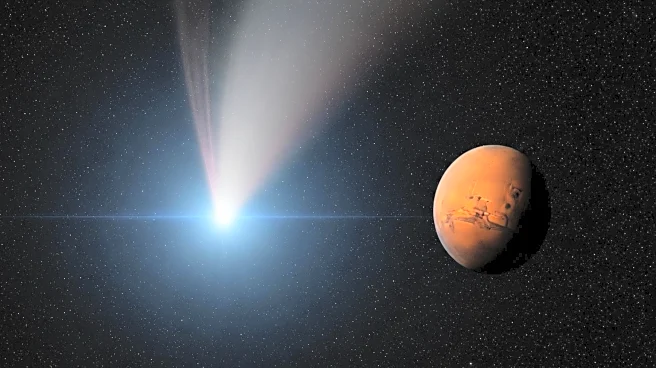What is the story about?
What's Happening?
NASA's ExoMars Trace Gas Orbiter has detected an unexpected surge in ozone levels within Mars's north polar vortex. This discovery was made possible despite the challenges posed by the total darkness of the Martian winter, which typically hinders atmospheric studies. The ExoMars mission, equipped with the Atmospheric Chemistry Suite, has been pivotal in analyzing the Martian atmosphere by measuring sunlight absorption at various wavelengths. However, during the polar night, alternative data sources like the Mars Climate Sounder instrument on NASA's Mars Reconnaissance Orbiter are used to gather temperature measurements. These findings suggest that the extreme cold within the vortex, which is about 40 degrees Celsius colder than the surrounding areas, contributes to the rise in ozone levels. This phenomenon could provide insights into Mars's past atmospheric conditions and its potential for sustaining life.
Why It's Important?
The discovery of increased ozone levels in Mars's polar vortex is significant as it may offer clues about the planet's historical atmospheric conditions. Understanding these conditions is crucial for assessing Mars's potential to have supported life in the past. If Mars once had a protective ozone layer similar to Earth's, it could have shielded the surface from harmful ultraviolet radiation, enhancing its habitability. This information is vital for future missions, such as the European Space Agency's ExoMars Rosalind Franklin rover mission, which aims to search for signs of ancient life on Mars. The study of Martian atmospheric dynamics and chemical processes could inform the focus and findings of these missions, potentially reshaping our understanding of Mars's history and its capacity to support life.
What's Next?
Future Mars exploration missions will likely incorporate these findings to refine their search for signs of ancient life. The ExoMars Rosalind Franklin rover, set for launch in 2028, will benefit from this enhanced understanding of Martian atmospheric conditions. Researchers will continue to study the polar vortex and its impact on ozone levels to gain deeper insights into Mars's climatic history. These efforts could lead to the identification of regions on Mars that are of particular interest for exploration, potentially revealing more about the planet's ability to support life in its ancient past.
AI Generated Content
Do you find this article useful?













